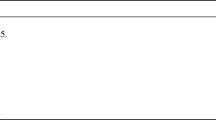Abstract
This paper presents a statistical model for textures that uses a non-negative decomposition on a set of local atoms learned from an exemplar. This model is described by the variances and kurtosis of the marginals of the decomposition of patches in the learned dictionary. A fast sampling algorithm allows to draw a typical image from this model. The resulting texture synthesis captures the geometric features of the original exemplar. To speed up synthesis and generate structures of various sizes, a multi-scale process is used. Applications to texture synthesis, image inpainting and texture segmentation are presented.
Access this chapter
Tax calculation will be finalised at checkout
Purchases are for personal use only
Preview
Unable to display preview. Download preview PDF.
Similar content being viewed by others
References
Efros, A.A., Leung, T.K.: Texture synthesis by non-parametric sampling. In: ICCV ’99: Proceedings of the International Conference on Computer Vision, vol. 2, p. 1033. IEEE Computer Society Press, Los Alamitos (1999)
Wei, L.-Y., Levoy, M.: Fast texture synthesis using tree-structured vector quantization. In: SIGGRAPH ’00: Proceedings of the 27th annual conference on Computer graphics and interactive techniques, pp. 479–488. ACM Press, New York (2000), doi:10.1145/344779.345009
Lefebvre, S., Hoppe, H.: Parallel controllable texture synthesis. ACM Trans. Graph. 24(3), 777–786 (2005), doi:10.1145/1073204.1073261
Julesz, B.: Visual pattern discrimination. IRE Trans. Inform. Theory 8(2), 84–92 (1962)
Zhu, S.C., Wu, Y., Mumford, D.: Filters, random fields and maximum entropy (FRAME): Towards a unified theory for texture modeling. Int. J. Comput. Vision 27(2), 107–126 (1998)
Heeger, D.J., Bergen, J.R.: Pyramid-Based texture analysis/synthesis. In: Cook, R. (ed.) SIGGRAPH 95 Conference Proceedings, Aug. 1995. Annual Conference Series, pp. 229–238. Addison-Wesley, Reading (1995)
Perlin, K.: An image synthesizer. In: SIGGRAPH ’85: Proceedings of the 12th annual conference on Computer graphics and interactive techniques, pp. 287–296. ACM Press, New York (1985), doi:10.1145/325334.325247
Portilla, J., Simoncelli, E.P.: A parametric texture model based on joint statistics of complex wavelet coefficients. Int. J. Comput. Vision 40(1), 49–70 (2000)
Attneave, F.: Some informational aspects of visual perception. Psychological Review 61, 183–193 (1954)
Barlow, H.B.: Possible principles underlying the transformation of sensory messages. In: Rosenblith, W.A. (ed.) Sensory Communication, pp. 217–234. MIT Press, Cambridge (1961)
Mallat, S.: A Wavelet Tour of Signal Processing. Academic Press, San Diego (1998)
Candès, E., Donoho, D.: New tight frames of curvelets and optimal representations of objects with piecewise \(\text{C}^2\) singularities. Comm. Pure Appl. Math. 57(2), 219–266 (2004)
Le Pennec, E., Mallat, S.: Bandelet Image Approximation and Compression. SIAM Multiscale Modeling and Simulation 4(3), 992–1039 (2005)
Olshausen, B.A., Field, D.J.: Emergence of simple-cell receptive-field properties by learning a sparse code for natural images. Nature 381(6583), 607–609 (1996)
Aharon, M., Elad, M., Bruckstein, A.: The k-svd: An algorithm for designing of overcomplete dictionaries for sparse representation. IEEE Trans. On Signal Processing (to appear) (2006)
Tropp, J.A., et al.: Designing structured tight frames via an alternating projection method. IEEE Trans. on Information Theory 51(1), 188–209 (2005)
Chen, Y.-W., et al.: Selection of ICA Features for Texture Classification. In: Wang, J., Liao, X.-F., Yi, Z. (eds.) ISNN 2005. LNCS, vol. 3497, pp. 262–267. Springer, Heidelberg (2005)
Skretting, K., Husoy, J.: Texture classification using sparse frame based representations. EURASIP Journal on Applied Signal Processing, to appear (2006)
Manduchi, R., Portilla, J.: Independent component analysis of textures. In: ICCV, pp. 1054–1060 (1999)
Lee, D.D., Seung, H.S.: Learning the parts of objects by non-negative matrix factorization. Nature 401, 788–791 (1999)
Donoho, D., Stodden, V.: When does non-negative matrix factorization give a correct decomposition into parts? In: Thrun, S., Saul, L., Schölkopf, B. (eds.) Advances in Neural Information Processing Systems 16, MIT Press, Cambridge (2004)
Lee, D.D., Seung, H.S.: Algorithms for non-negative matrix factorization. In: Advances in Neural Information Processing Systems 13, MIT Press, Cambridge (2001)
Hoyer, P.O.: Non-negative matrix factorization with sparseness constraints. Journal of Machine Learning Research 5, 1457–1469 (2004)
Bertalmio, M., et al.: Image inpainting. In: Siggraph 2000, pp. 417–424 (2000)
Fadili, M.J., Starck, J.-L.: Em algorithm for sparse representation-based image inpainting. In: IEEE International Conference on Image Processing, vol. II, pp. 61–63. IEEE Computer Society Press, Los Alamitos (2005)
Grimes, D.B., Rao, R.P.N.: Bilinear sparse coding for invariant vision. Neural Computation 17(1), 47–73 (2005)
Author information
Authors and Affiliations
Editor information
Rights and permissions
Copyright information
© 2007 Springer Berlin Heidelberg
About this paper
Cite this paper
Peyré, G. (2007). Non-negative Sparse Modeling of Textures. In: Sgallari, F., Murli, A., Paragios, N. (eds) Scale Space and Variational Methods in Computer Vision. SSVM 2007. Lecture Notes in Computer Science, vol 4485. Springer, Berlin, Heidelberg. https://doi.org/10.1007/978-3-540-72823-8_54
Download citation
DOI: https://doi.org/10.1007/978-3-540-72823-8_54
Publisher Name: Springer, Berlin, Heidelberg
Print ISBN: 978-3-540-72822-1
Online ISBN: 978-3-540-72823-8
eBook Packages: Computer ScienceComputer Science (R0)




